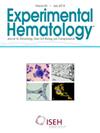Ontogeny, dynamics, and characteristics of neutrophils during the perinatal period
IF 2.1
4区 医学
Q2 HEMATOLOGY
引用次数: 0
Abstract
This review examined the dynamic development and unique characteristics of neutrophils during the perinatal period, a critical window when the immune system undergoes rapid reprogramming, based on the mouse studies. In the mouse fetal liver—the primary hematopoietic niche before birth—hematopoietic stem cells and progenitor cells expand in parallel, with granulocyte–monocyte progenitors preferentially differentiating into neutrophils during late gestation. This process, partly driven by granulocyte colony-stimulating factor (G-CSF), substantially increases the number of neutrophils, preparing the neonates for microbial challenges after birth. After birth, there is a surge in circulating neutrophils, likely due to the mobilization of neutrophils from the liver, followed by a microbiota-dependent activation of granulopoiesis in the bone marrow. In addition to their antimicrobial functions, neonatal neutrophils exhibit immunomodulatory characteristics, such as reduced proinflammatory signaling and diminished neutrophil extracellular trap formation. These traits may contribute to tolerance to the microbes and help mitigate excessive inflammation. Finally, unresolved issues related to the phenotypic diversity and precise physiological roles of neutrophils during the perinatal period are addressed, highlighting the need for further research.
围产期中性粒细胞的个体发生、动态和特征。
本文综述了基于小鼠研究的围产期中性粒细胞的动态发展和独特特征,围产期是免疫系统经历快速重编程的关键时期。在小鼠胎儿肝脏(出生前的主要造血生态位)中,造血干细胞和祖细胞平行扩增,粒细胞-单核细胞祖细胞在妊娠后期优先分化为中性粒细胞。这个过程部分由粒细胞集落刺激因子(G-CSF)驱动,大大增加中性粒细胞的数量,为新生儿出生后的微生物挑战做好准备。出生后,循环中性粒细胞激增,可能是由于肝脏中中性粒细胞的动员,随后是骨髓中依赖微生物的粒细胞生成激活。除了抗菌功能外,新生儿中性粒细胞还表现出免疫调节特性,如减少促炎信号和减少中性粒细胞胞外陷阱的形成。这些特征可能有助于对微生物的耐受性,并有助于减轻过度的炎症。最后,解决了与围产期中性粒细胞表型多样性和精确生理作用相关的未解决问题,强调了进一步研究的必要性。摘要本文主要以小鼠研究为基础,对围产期中性粒细胞的动态发育进行了综述。在小鼠胎儿肝脏中,造血干细胞和祖细胞平行扩张,中性粒细胞大量积累,为新生儿应对出生后的微生物挑战做好准备。出生后,由于肝脏动员和随后的微生物群驱动的骨髓颗粒生成,中性粒细胞数量激增。除了抗菌作用外,新生儿中性粒细胞还具有免疫调节功能,可能有助于控制过度炎症。解决了有关其多样性和功能的未解决问题。
本文章由计算机程序翻译,如有差异,请以英文原文为准。
求助全文
约1分钟内获得全文
求助全文
来源期刊

Experimental hematology
医学-血液学
CiteScore
5.30
自引率
0.00%
发文量
84
审稿时长
58 days
期刊介绍:
Experimental Hematology publishes new findings, methodologies, reviews and perspectives in all areas of hematology and immune cell formation on a monthly basis that may include Special Issues on particular topics of current interest. The overall goal is to report new insights into how normal blood cells are produced, how their production is normally regulated, mechanisms that contribute to hematological diseases and new approaches to their treatment. Specific topics may include relevant developmental and aging processes, stem cell biology, analyses of intrinsic and extrinsic regulatory mechanisms, in vitro behavior of primary cells, clonal tracking, molecular and omics analyses, metabolism, epigenetics, bioengineering approaches, studies in model organisms, novel clinical observations, transplantation biology and new therapeutic avenues.
 求助内容:
求助内容: 应助结果提醒方式:
应助结果提醒方式:


